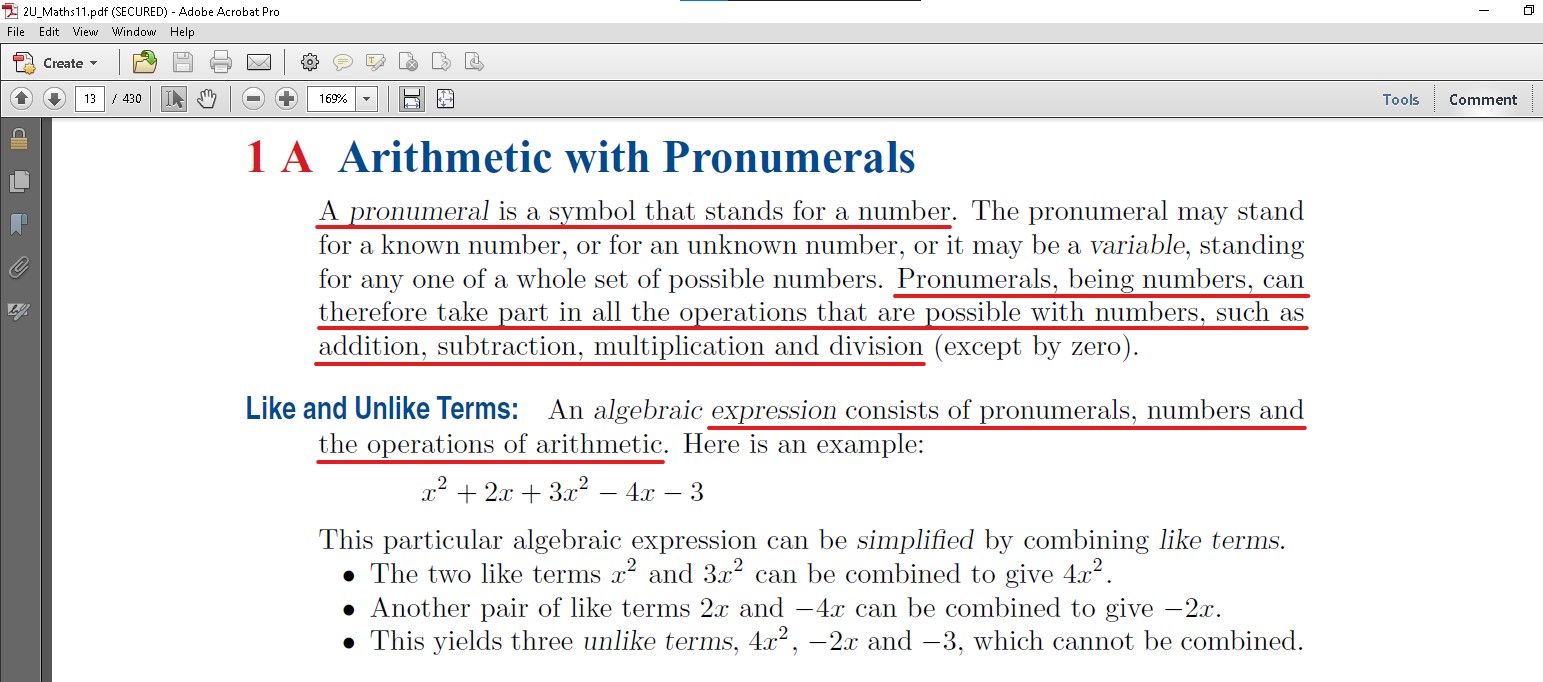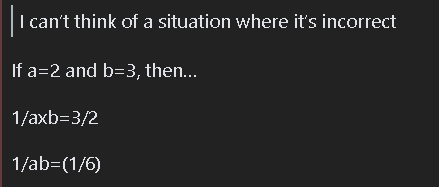

-5**2 is apparently -25 because of the order of operations)
Which is correct


-5**2 is apparently -25 because of the order of operations)
Which is correct
It’s only a wrong answer
Really? You want to do that again? Ok, fine… If I have 1 2 litre bottle of milk, and 4 3 litre bottles of milk - i.e. 2+3x4 - how many litres of milk do I have?
you would with the standard order of operations
The definition of 5 as being 1+1+1+1+1 has nothing to do with order of operations.
there is no law of the universe that makes 5 look like that
No, but there is a rule of Maths which defines it.
switch the definitions of the symbols 5 and 4 if we did it all at once and revised old math expressions to match the new standard
In other words everything would be the same as now but we just switched the notation around. I already said that to you a while back. Now you’re getting it.
there is no reason the order of operations is what it is other than that is how someone decided to write it
Got nothing to do with how it’s written - Maths is written differently in many different countries, and yet the underlying order of operations rules are universal.
I’m not saying you can take any expression and get the same answer by doing addition before multiplication
And if it’s not the same answer then it’s wrong. You’re nearly had it.
I’m saying you can take any problem and get the correct answer by doing addition before multiplication
And I told you you can’t. Waiting on a proof from you. Start with 2+3x4 - show me how you can get the correct answer by doing addition first - it’s a nice simple one. :-)
that means I would use the expression 2+(3x4) because 2+3x4
They’re literally the same thing.
All I am saying is that you can still use numbers to solve problems with an altered order of operations, or by altering any part of the system of notation
And I told you that it’s impossible. Changing the notation doesn’t change the Maths.
As you can see, I used my altered math notation to find the correct answer
BWAHAHAHAHA! Nope! I see you putting brackets around the multiplication to make sure it gets done first - same as if you hadn’t used brackets at all! It’s the exact same notation we use now, just with some redundant brackets added to it! And, predictably, you left the addition for last.
Ok, let’s take your example and do addition first (like you claimed can be done)…
15²+50²=15x15+50x50=15x65x50=48,750. But 15²+50² is 2,725 according to my calculator. Ooooh, different answers - I wonder which one is right… I wonder which one is right…???
Thanks for proving it can only be done by following the order of operations rules (just like I’ve been saying to you all along). Bye now.
I think you misunderstand my argument
No, you demonstrably didn’t understand mine, which is, what you are saying is impossible, but you’re still saying it’s possible.
I could use still math to solve a real-world problem with an altered order of operations
No, you can’t. You already tried to do addition first in 2+3x4 and found out why it doesn’t work. Ever since then you’ve been ignoring that result and pretending that there’s some other way to make it work. No, there isn’t. As long as multiplication is defined in terms of addition (i.e. 3x4=3+3+3+3) then it’s impossible to get a right answer unless you do multiplication before addition.
You could still do anything you can do with regular math, if you had a different order of operations
No, you can’t. Again, you already proved you can’t.
Do you need me to calculate something, to prove it to you?
Go ahead - I’m not holding my breath. I already told you why it literally can’t work. But note that adding brackets isn’t changing the order of operations - brackets are already part of the order of operations. Writing 2+3x4 as 2+(3x4) is exactly the same thing.
BTW just to FURTHER prove your “addition first” doesn’t work, look at this example…
3x4+2=3x6=18. But earlier you did 2+3x4=5x4=20 - not even the same answer in an “addition first” world! Welcome to why it’s impossible to make addition-first work. But knock yourself out - you’re welcome to try! 😂
The order of operations is just part of a system of notation
No, it isn’t. It’s part of the rules of Maths. Notation is how you write it - underlying that is how Maths actually works. This is embodied in the rules of Maths.
is inherently arbitrary
Completely fixed, and a result of the way the operators are defined - that was the only “arbitrary” bit, deciding what the operators were and what they were going to mean, but once you did that then the order of operations rules were already written for you (having already been determined as soon as you made the definitions of the operators in the first place).
number 5 has no inherent meaning behind it other than the convention of how we interpret it
Again, not a convention, a rule of how to interpret it. You can’t just decide to interpret 5 as four, or again, you end up with wrong answers. The rules of Maths prevent you from getting wrong answers. You found that out yourself when you tried to do addition first in 2+3x4.
Noted that you didn’t answer my question - the answer is I have 14 litres of milk. 2+3+3+3+3=14 litres. When you did “arbitrary addition first”, you got 20, which is wrong, which is why no other order of operations rules work than the ones we have.
You can’t change how equations work and then expect all equations to work the same after the change
In actual fact the point is that they will except for what ever your new notation is. e.g. if we instead defined + to mean multiply, and x to mean add, then we would do + before x, and again, that would be the only order of operations which works. i.e. the only order which gives us 14 litres.
that doesn’t mean there is anything fundamentally wrong with having a different system of writing equations in which operations are executed in a different order
No, and if you did that, you would again arrive at only one order of operations rules which works, cos I still have 14 litres, and the Maths in this new system still has to give an answer of 14 litres, not 20.
Our whole system of writing equations is just a convention
Nope, it’s all rules, found in any Maths textbook, and if you don’t obey the rules you get wrong answers (like you did when you got 20).
But there is no fundamental truth behind it
Yes there is - I have 14 litres, and only 1 set of order of operations rules gives that answer.
only that it is simpler for the majority of use cases
If you follow the rules of Maths then it is correct for every use case. That’s why they exist in the first place.
5+5+5+5=20. What is the issue with that?
That it’s wrong. If I have 1 2 litre bottle of milk, and 4 3 litre bottles of milk - i.e. 2+3x4 - how many litres of milk do I have? Without even doing the arithmetic, just count it up and tell me how many litres there is.
2y, should take higher priority simply because it cannot be any further resolved or simplified
Bingo!
That is not the case with, say, 2(3+1)
It’s the same thing, where y=3+1.
1/7y. Is the coefficient 7, or is it 1/7? i.e. Is that 1/(7y)
Yes, it’s 1/(7y) as per the definition of Terms.
Either way, if that’s not the the standard understood by everyone
It’s the standard in literally every Maths textbook.
“Wrong answers” only according to our current order of operations
No, according to arithmetic.
math still works if you, for example, make additions come first
No, it doesn’t - order of operations proof. The only way it could work with addition first is if we swapped the definitions of addition and multiplication around… but then we still have the same order of operations, all we’ve done is swapped around what we call addition and multiplication!
there is no ‘high truth’ behind it.
There is when it comes to order of operations.
That proof for the order of operations sure seems to rely a lot on our current order of operations
Doesn’t use order of operations at all. It only uses the definitions of the operators. i.e. 3x4=3+3+3+3 by definition. i.e. nothing to do with order of operations.
If I have 1 2l bottle of milk, and 4 3l bottles of milk, how many litres of milk do I have? It can be solved by simply adding them up - again, nothing to do with order of operations here, just simple addition. Now, write it out as a mathematical expression which uses multiplication, and tell me which order of operations gets you the right answer. Voila! Welcome to how we worked out what the order of operations rules had to be.
That’s an after the fact justification
You got some sources with dates in them to show it was “after”, and not, you know, before?
Please see this section of Wikipedia on the order of operations
That section is about multiplication, and there isn’t any multiplication in this expression.
The “math” itself might not be ambiguous, but how we write it down absolutely can be
Not in this case it isn’t. It has been written in a way which obeys all the rules of Maths.
This is why you don’t see actual mathematicians arguing over which one of these calculators is correct
But I do! I see University lecturers - who have forgotten their high school Maths rules (which is where this topic is taught) - arguing about it.
it is not either calculator being wrong
Yes, it is. The app written by the programmer is ignoring The Distributive Law (most likely because the programmer has forgotten it and not bothered to check his Maths is correct first).
US - PEMDAS vs UK - BODMAS
Those aren’t the rules. They are mnemonics to help you remember the rules
notice division and multiplication swapped places
Yes, that’s right, because they have equal precedence and it literally doesn’t matter which way around you do them.
you can’t actually do all of the multiplication and division at one time
Yes, you can!
Some are taught to simply work left to right
Yes, that’s because that’s the easy way to obey the actual rule of Left associativity.
we are all taught to use parentheses correctly to eliminate ambiguity
Correct! So 2(2+2) unambiguously has to be done before the division.
Something about the way this thread was written was kind of confusing,
Ok, sorry about that. I’m more than happy to update it if you want to give me some constructive feedback on what was confusing about it. Note though that this was the 3rd part in the series, and maybe you didn’t go back and read the previous 2 parts? They start here
Is it just that the terminology is wrong? Or am I missing something?
Yes and yes. :-) The 2 actual rules of Maths that apply here are Terms and The Distributive Law. These are 2 different rules of Maths - neither of which is “multiplication” - and so when lumping them together as “implicit multiplication” you end up with unpredictable, and usually wrong, answers. The only way to always get the right answer is to follow the actual rules of Maths.
a x b, a*b, ab, and a(b) are all acceptable notations to describe the operation “multiply a and b.”
No, they’re not. The first two are multiplications, the second two are Terms. Note that a Term is a product, the result of a multiplication. In the mnemonics, “Multiplication”" refers literally to multiplication signs, and nothing else.
Calculate 8 ÷ 2a where a = 4. Then,
Calculate 8 ÷ 2 × a where a = 4.
See how in the first form a is implied to be part of the fraction where in the second it isn’t?
It’s not implied, it’s explicitly because of the definition of Terms.
P.S. now substitute a=2 and you’ll see why it matters.
A dot • could be between 2 and a and it would still follow the first example
No, it wouldn’t. Inserting a dot (multiplication) makes it the same as your second example. i.e. 3 Terms, not 2 Terms.
In vector multiplication, dot and cross products produce different results.
This isn’t vector multiplication. This is Year 7 algebra.
because brackets are leftmost you do them first
No, not because leftmost (did I say leftmost? No, I did not), because brackets. Brackets are always first in order of operations.
2(4)^2, wow we’re at a 2x^2
No, we’re at x^2, because 2(4) is a bracketed term, and order of operations rules is brackets before exponents, and to solve the brackets we have to distribute the 2, so 2(4)^2=(2x4)^2=8^2=64.
all sorts of properties. But they are not rules
Depends. The Distributive Property is a property, but The Distributive Law is a rule. Properties explain how/why things work, but rules have to be obeyed if you want to get the right answer. Terms is a rule, based on properties (similarly, The Distributive Law is a rule, which makes use of the Distributive Property).
they only apply when we have unknows
Are you referring to pronumerals? Textbooks are quite explicit that the same rules apply to pronumerals as to numerals (since pronumerals literally stand-in for numerals).

terms get prio because they are terms!?
Not priority, they are already fully solved because they are terms. If we have 2a, then there’s literally nothing to be done (except substitute a value for a if you’ve been told what it is). 2xa on the other hand needs to be multiplied (2 terms separated by a multiplication).
Noted that you ignored where I pointed out why it makes a difference

There are no mention of term prio in the book.
Which book? I don’t know what you’re talking about now.
we have a simplified expression
AKA Terms. And Terms are not expressions. Expressions are defined as being made up of Terms and operators. See previous textbook screenshot. 2a is a Term, 2xa is an Expression. And yes, you are right that a Term is a simplified expression, and being simplified, there is no further simplification to be done.
2x^2+3x+5 we call 2x^2 and 3x and 5 terms. And yes they get priority, not because we named them those, but because they are multiplications
No, they are Terms. There is no multiplication. Multiplication refers literally to multiplication symbols. A Term is a product. i.e. the result of a multiplication. That’s why they don’t have multiplication symbols in them - it has already been done.
using terms, as we just get a single number
EXACTLY!! When a=2 and b=3, ab=6, a single number. AKA a Term.
I totally understand why someone would use this, it’s easier
We use it because that’s how Maths works, and is a rule taught in all the textbooks, and has been for more than a century.
I forgot the name/keywords but if you read a calculator’s manual there must be a chapter or something regarding this exact issue.
The name is Term. You can read about this exact issue in Maths textbooks.
Especially if you teach physics
I teach Maths, on which much of Physics is built.
As for your sources, you still linked a blog post
In other words, you didn’t even read it. The sources are in it - there are Maths textbooks in it.
the one on the right is correct
No, it isn’t.
8/2×(2+2)
…isn’t the same thing as 8/2(2+2). You separated the term in the denominator, leading the (2+2) to get flipped into the numerator, hence wrong answer.
Schools only started teaching that rule relatively recently
Recently? The order of operations rules have been taught for more than a century (we can see them in Lennes’ letter).
The big stuff should happen first, then the more granular operations
The “big stuff” is stuff that is defined in terms of something else. i.e. exponents are shorthand for repeated multiplication… and multiplication is shorthand for repeated addition, hence they have to be done in that order or you get wrong answers.
My mom’s a mathematician, she got annoyed when I said that the order of operations is just arbitrary rules made up by people a couple thousand years ago
I’m not surprised. Here’s the proof of the order of operations rules. Also, the equals sign wasn’t invented until the 16th century, so only 500 years old at most (the earliest references to order of operations are over 400 years ago).
Problem with PEMDAS: Why Calculators Disagree https://youtu.be/4x-BcYCiKCk
Debunked here - she never once refers to an actual Maths textbook!
People in this thread need to watch this: https://youtu.be/lLCDca6dYpA
Debunked here. She managed to never once refer to an actual Maths textbook! Spoiler alert: everyone who has claimed it’s “ambiguous” has done the same thing - no references to any Maths textbooks.
Yeah, they’re doing an upgrade right now. Yes, it’s the Maths explanation - -25 is the correct answer.